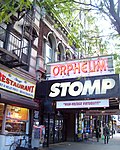German Evangelical Lutheran Church of St. Mark

German Evangelical Lutheran Church of St. Mark is a historic church and synagogue building at 323 East 6th Street between First and Second Avenues in the East Village neighborhood of Manhattan, New York City. The Renaissance Revival style church was built in 1847 by the Evangelical Lutheran Church of St. Matthew which first rented it to St. Mark's and subsequently sold it to them in 1857. By the end of the nineteenth century the congregation was in decline as congregants were moving elsewhere. Much of the church membership was killed in the 1904 General Slocum disaster, most of the victims being women and children, and the congregation never recovered.In 1940, the church was converted to the Community Synagogue Max D. Raiskin Center, an Orthodox Jewish congregation.
Excerpt from the Wikipedia article German Evangelical Lutheran Church of St. Mark (License: CC BY-SA 3.0, Authors, Images).German Evangelical Lutheran Church of St. Mark
East 6th Street, New York Manhattan
Geographical coordinates (GPS) Address Nearby Places Show on map
Geographical coordinates (GPS)
| Latitude | Longitude |
|---|---|
| N 40.726944444444 ° | E -73.987222222222 ° |
Address
East 6th Street 325
10003 New York, Manhattan
New York, United States
Open on Google Maps






